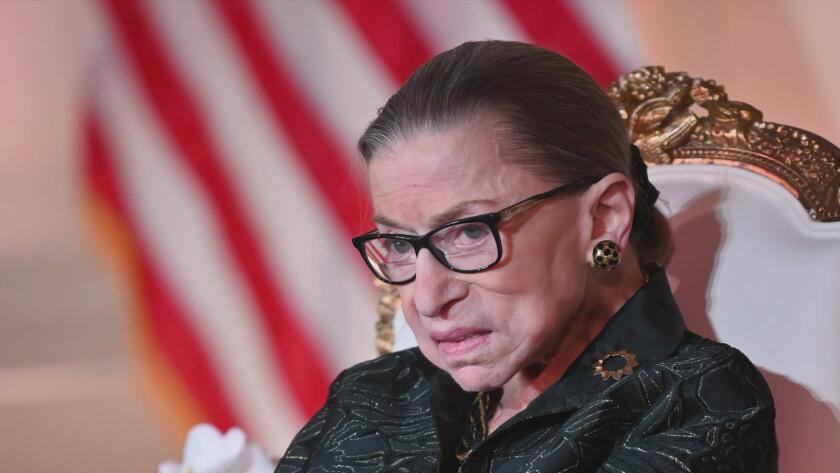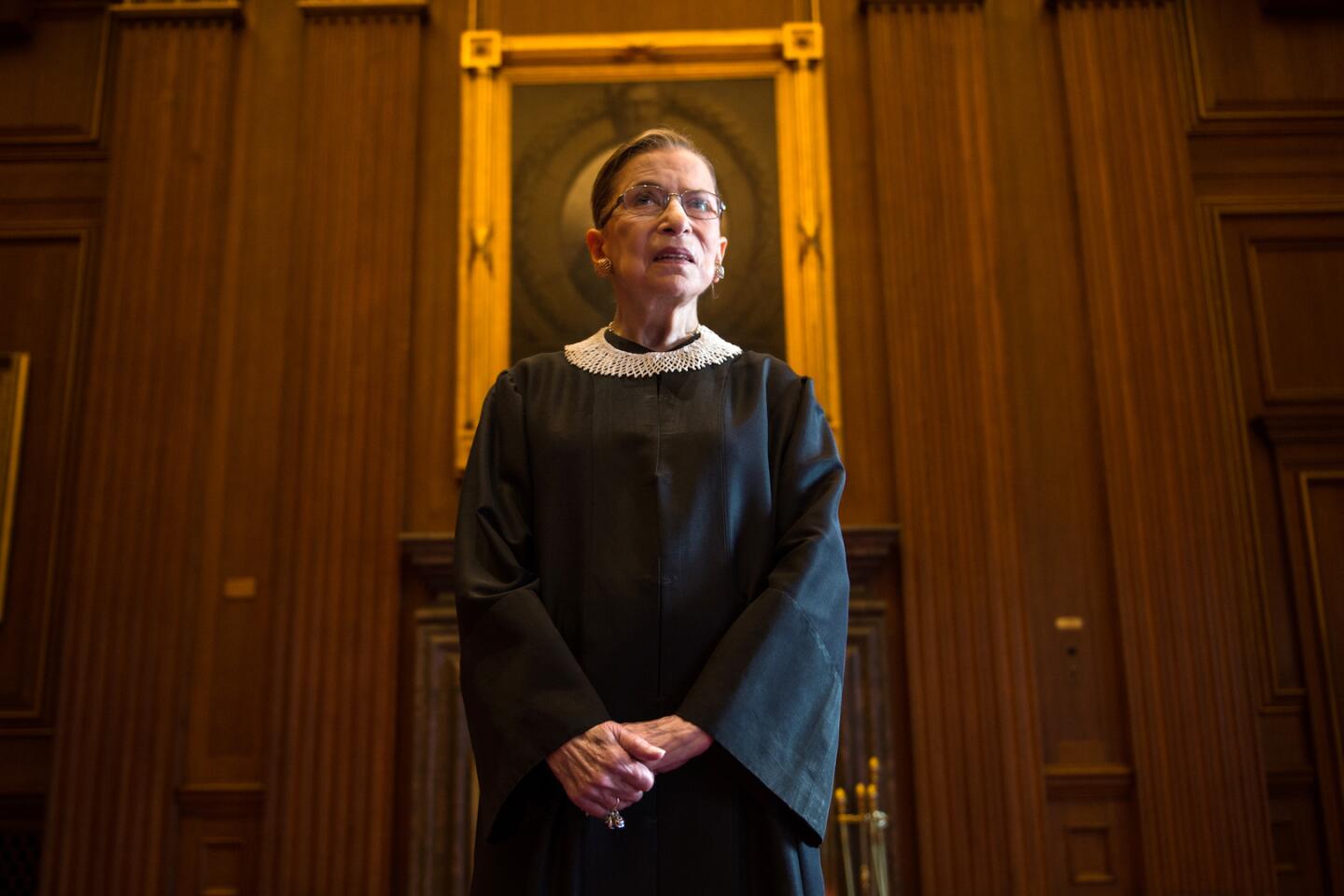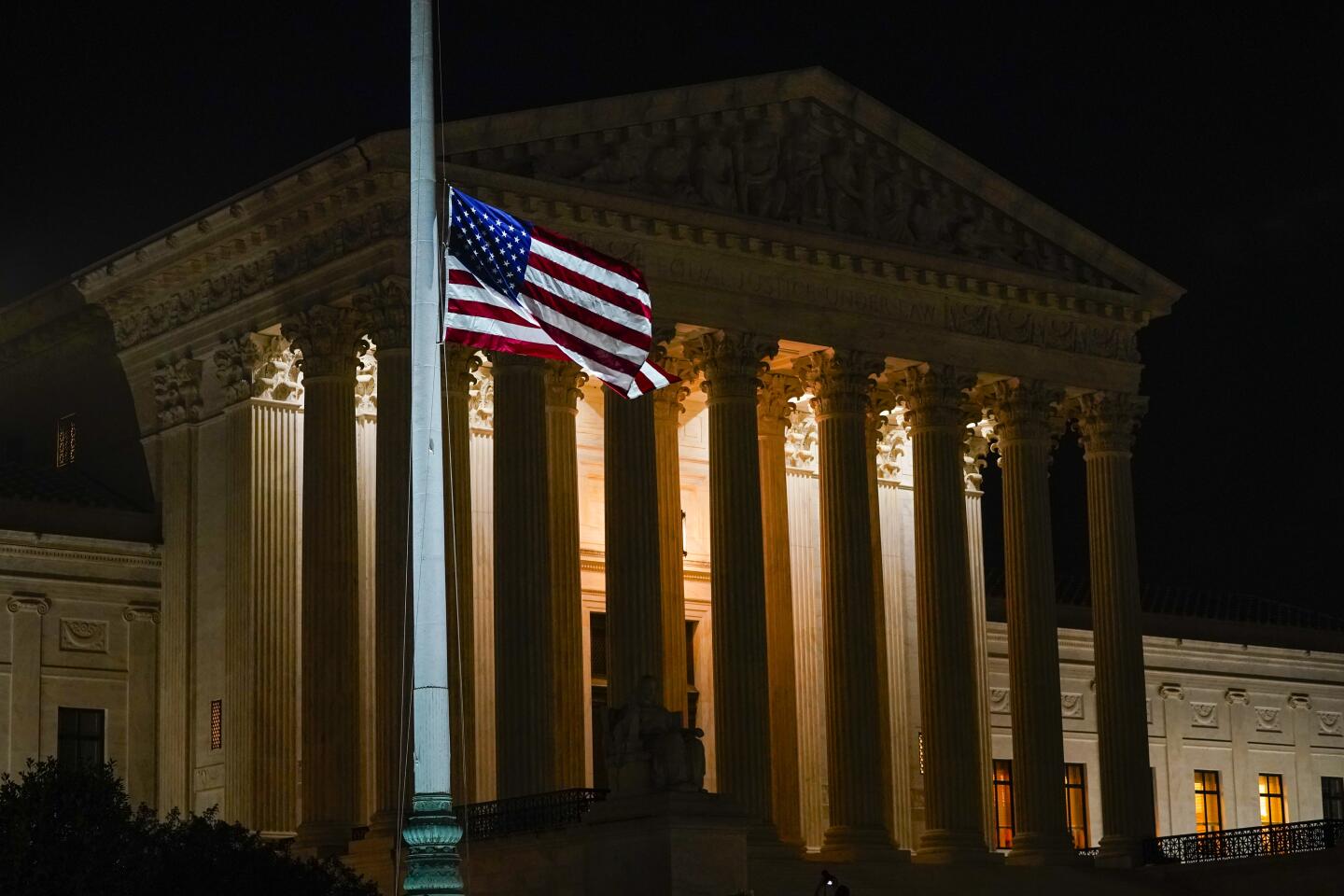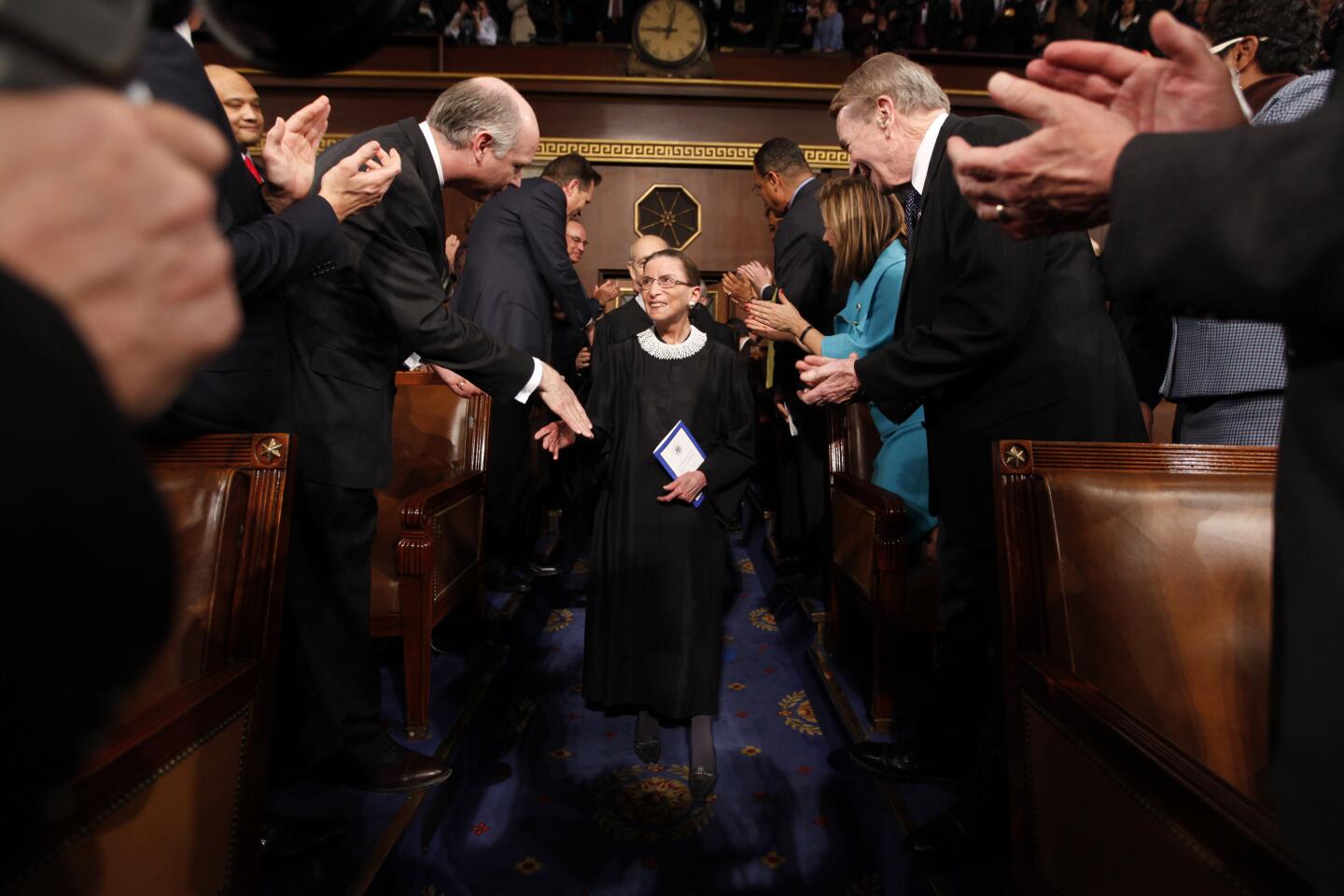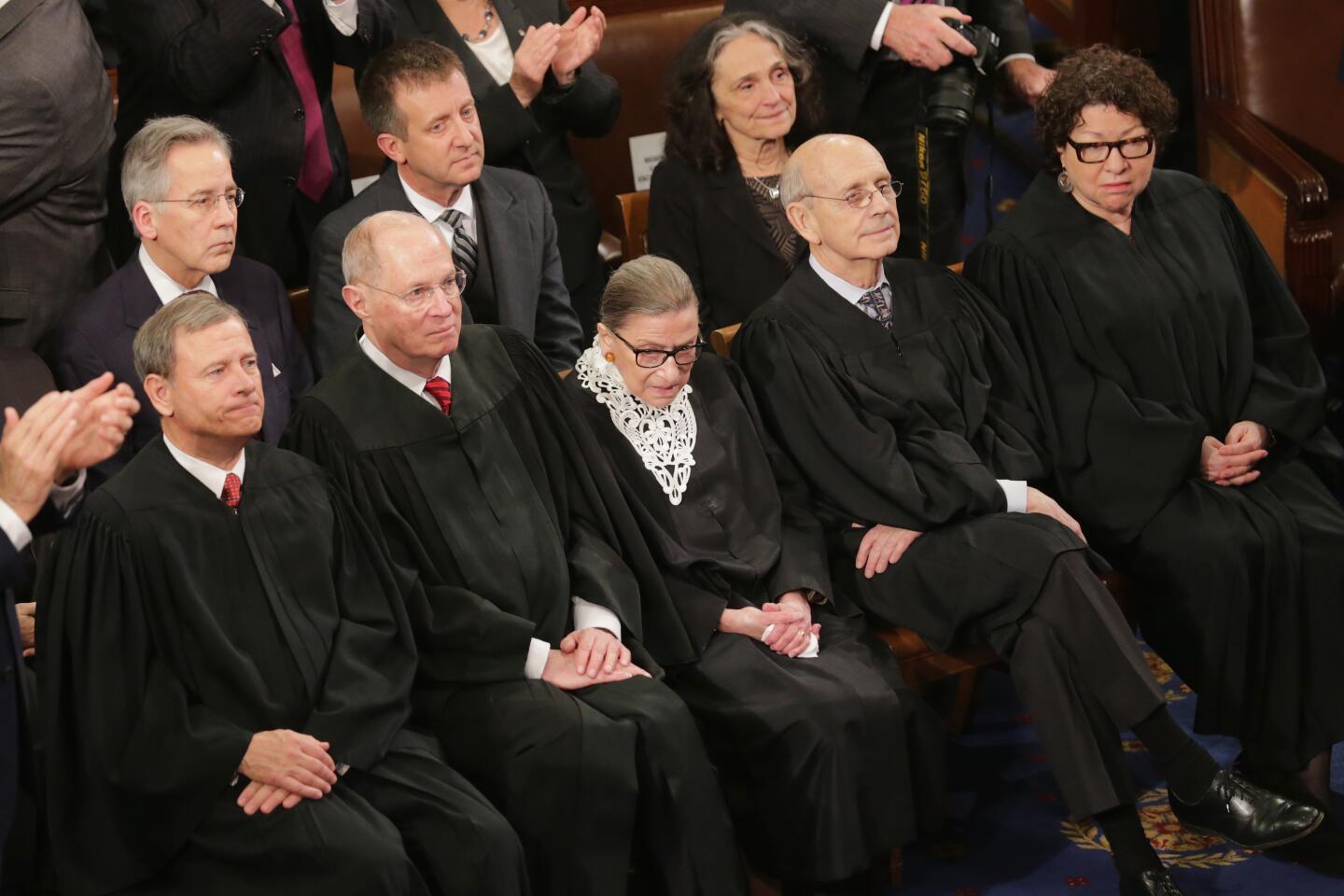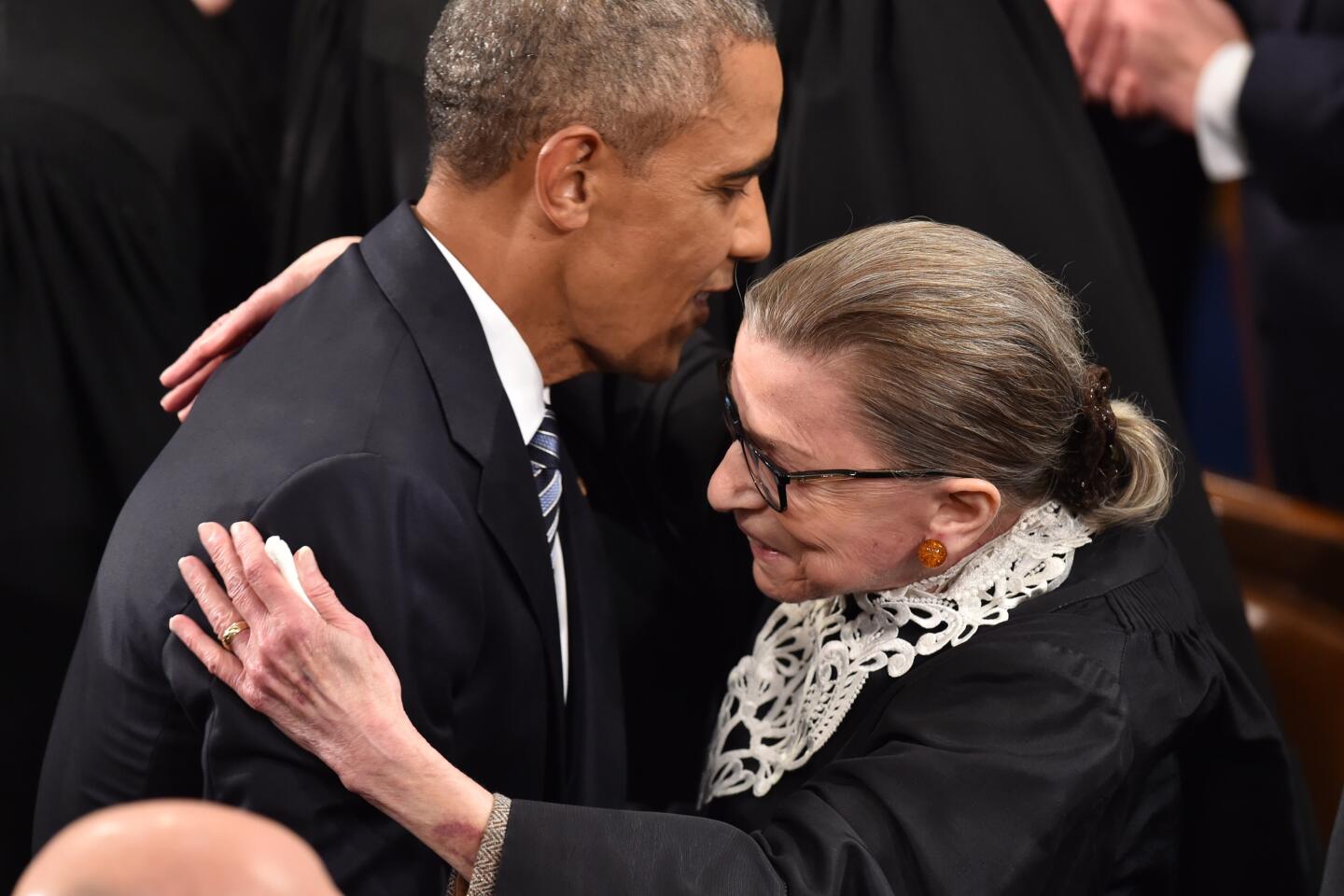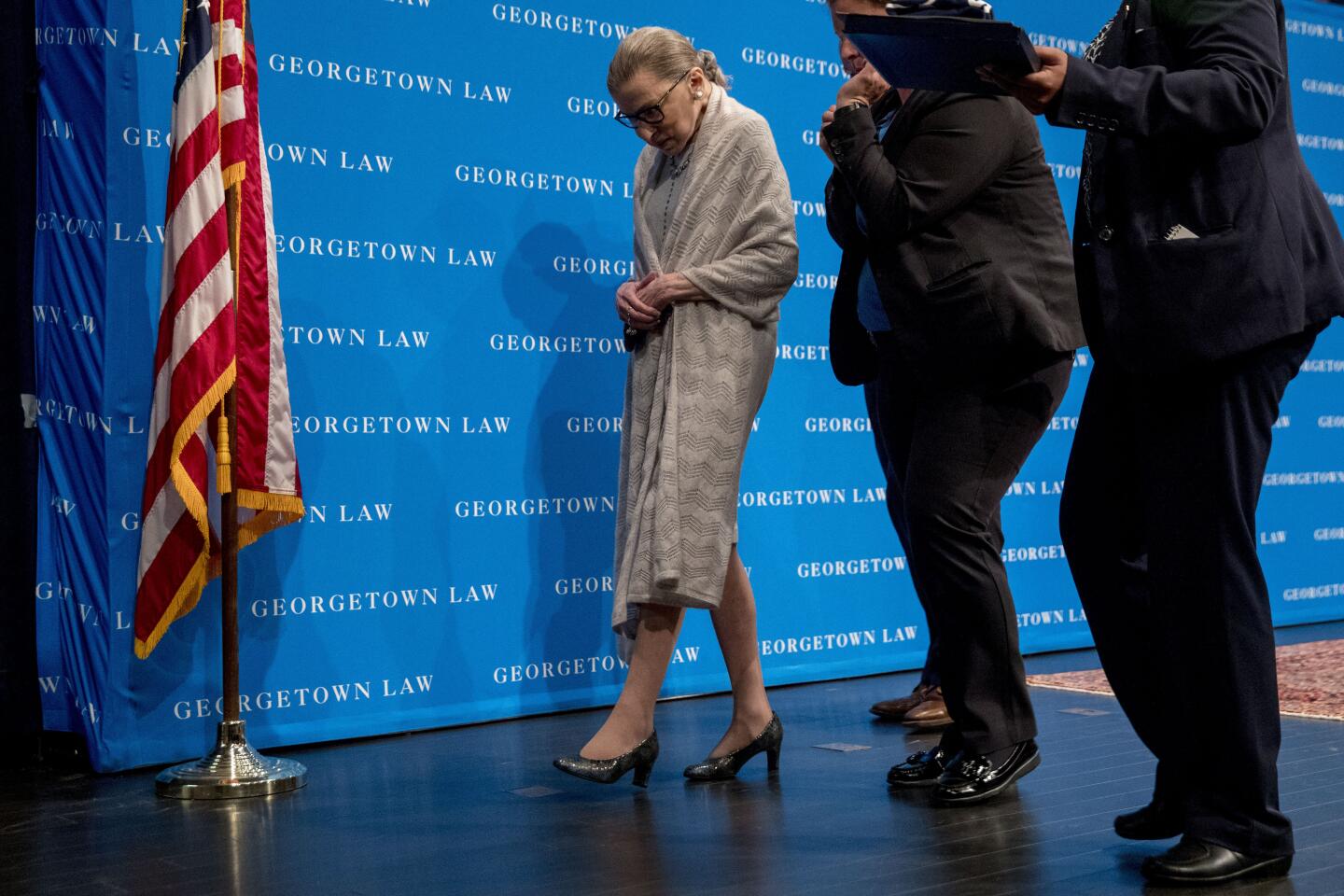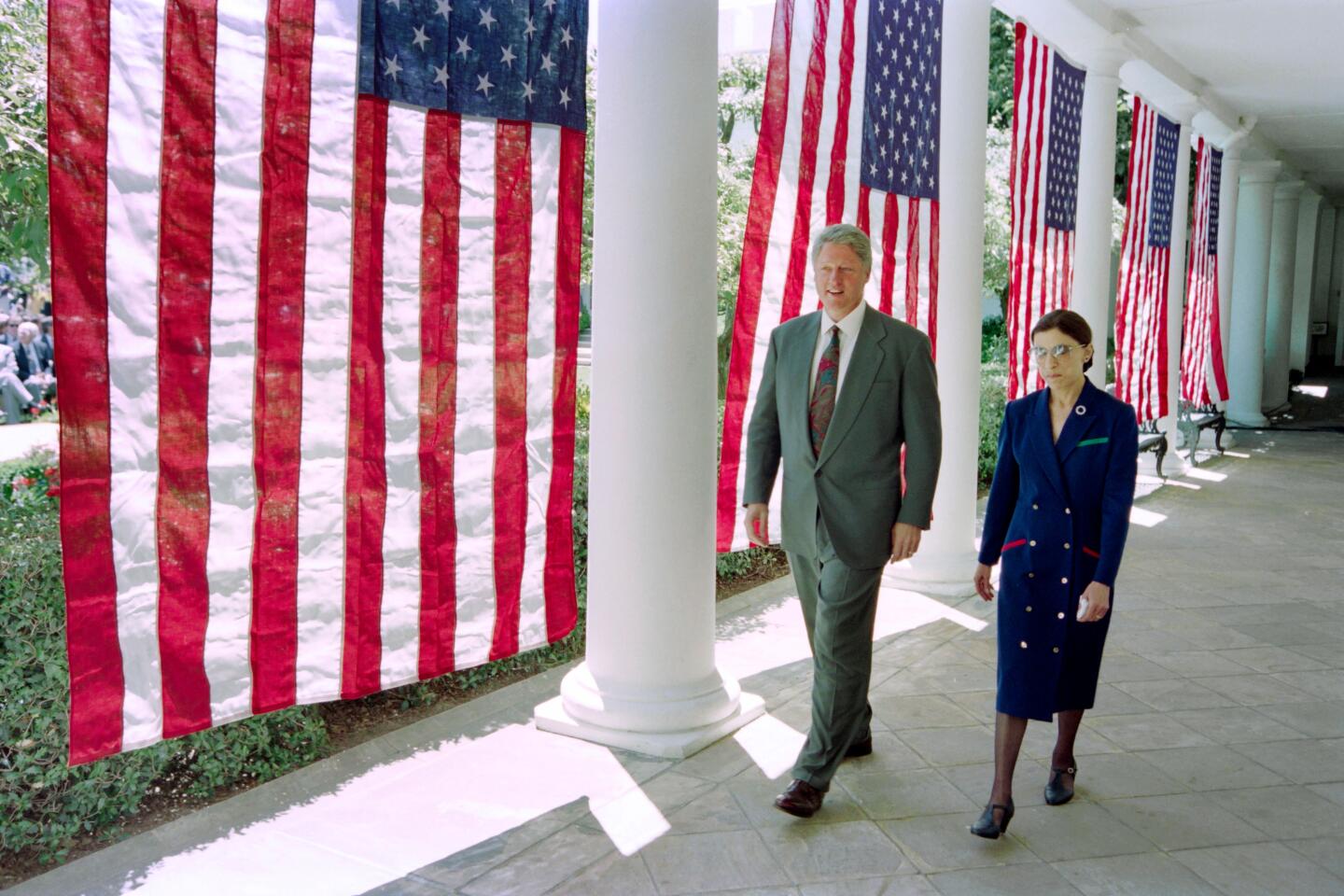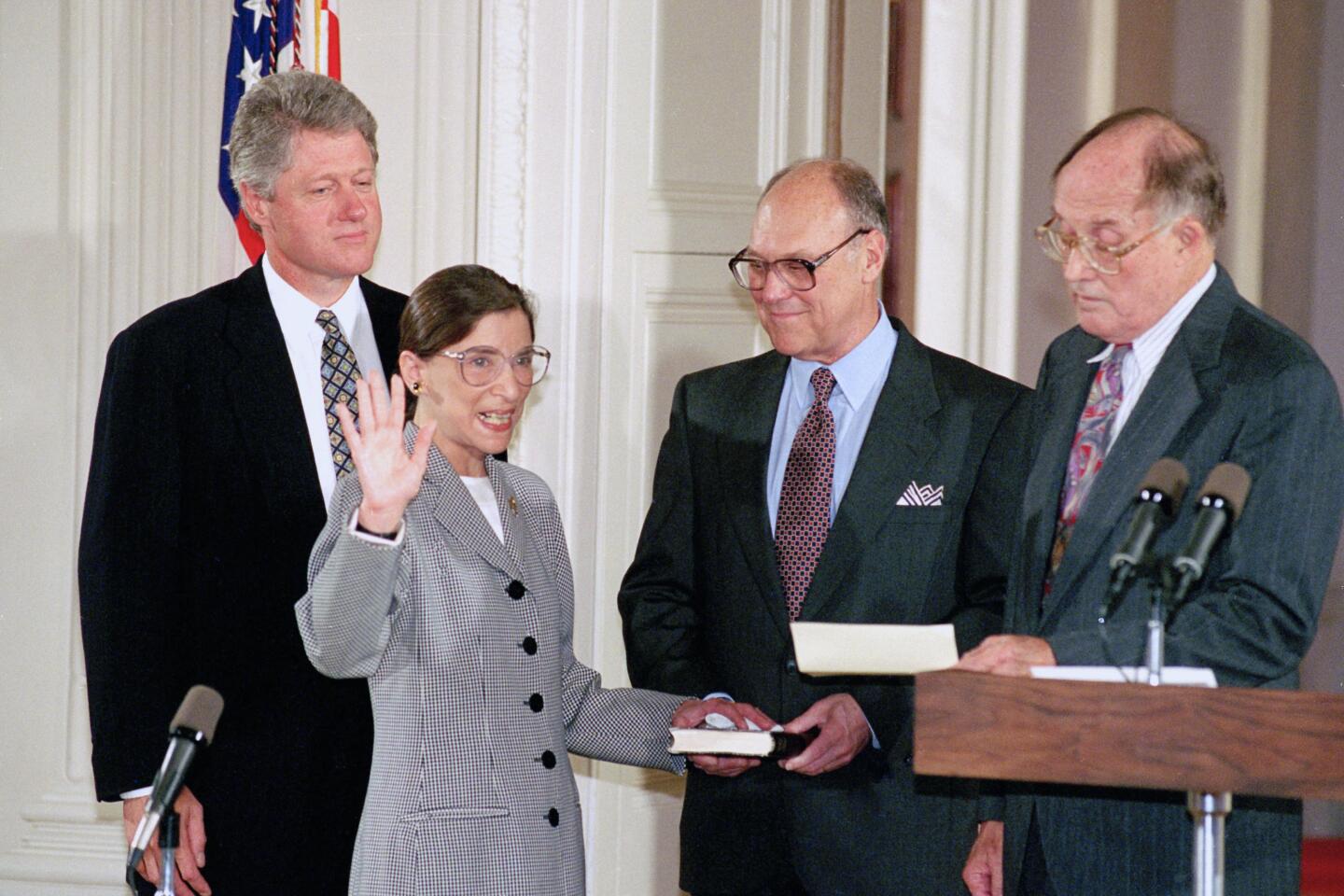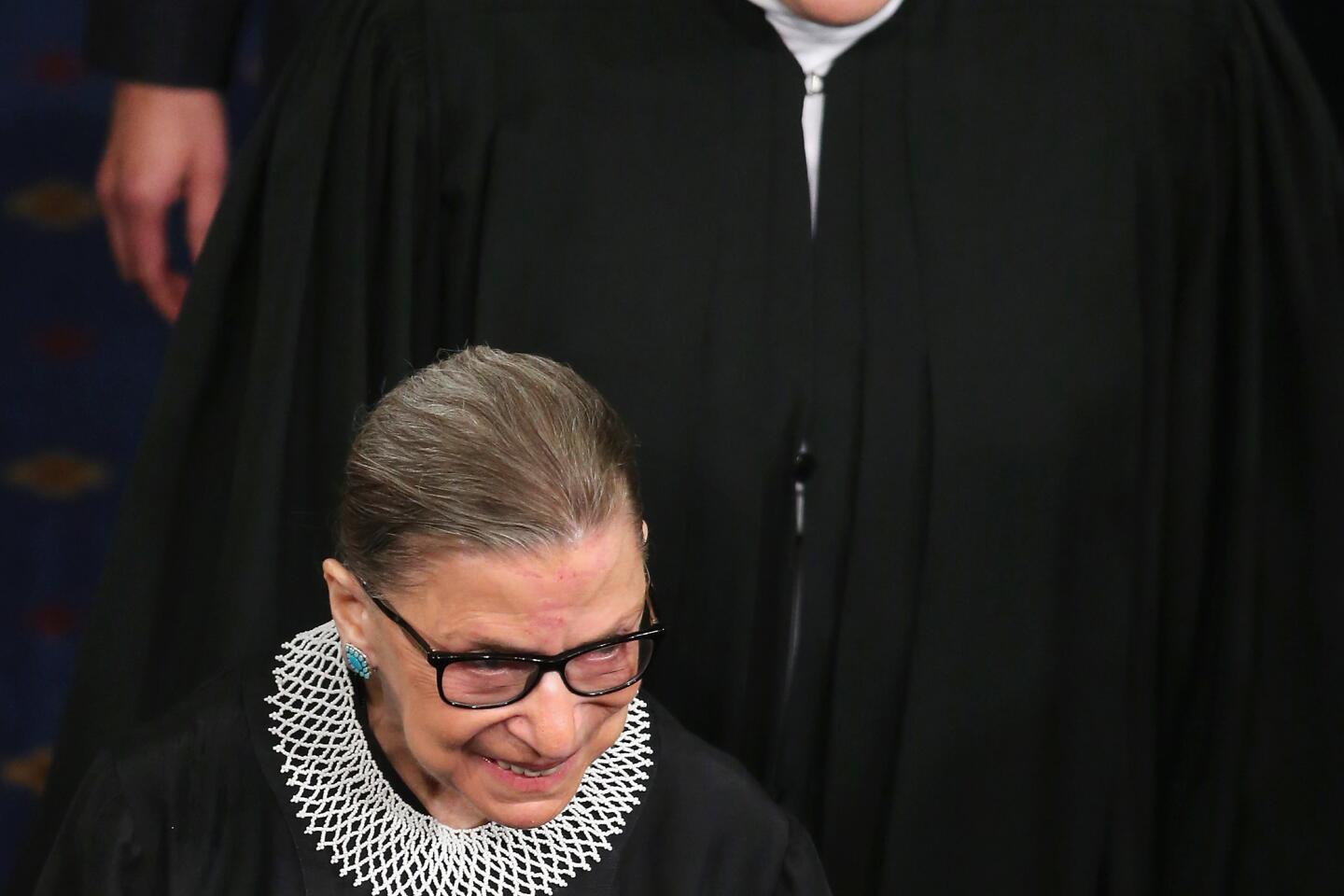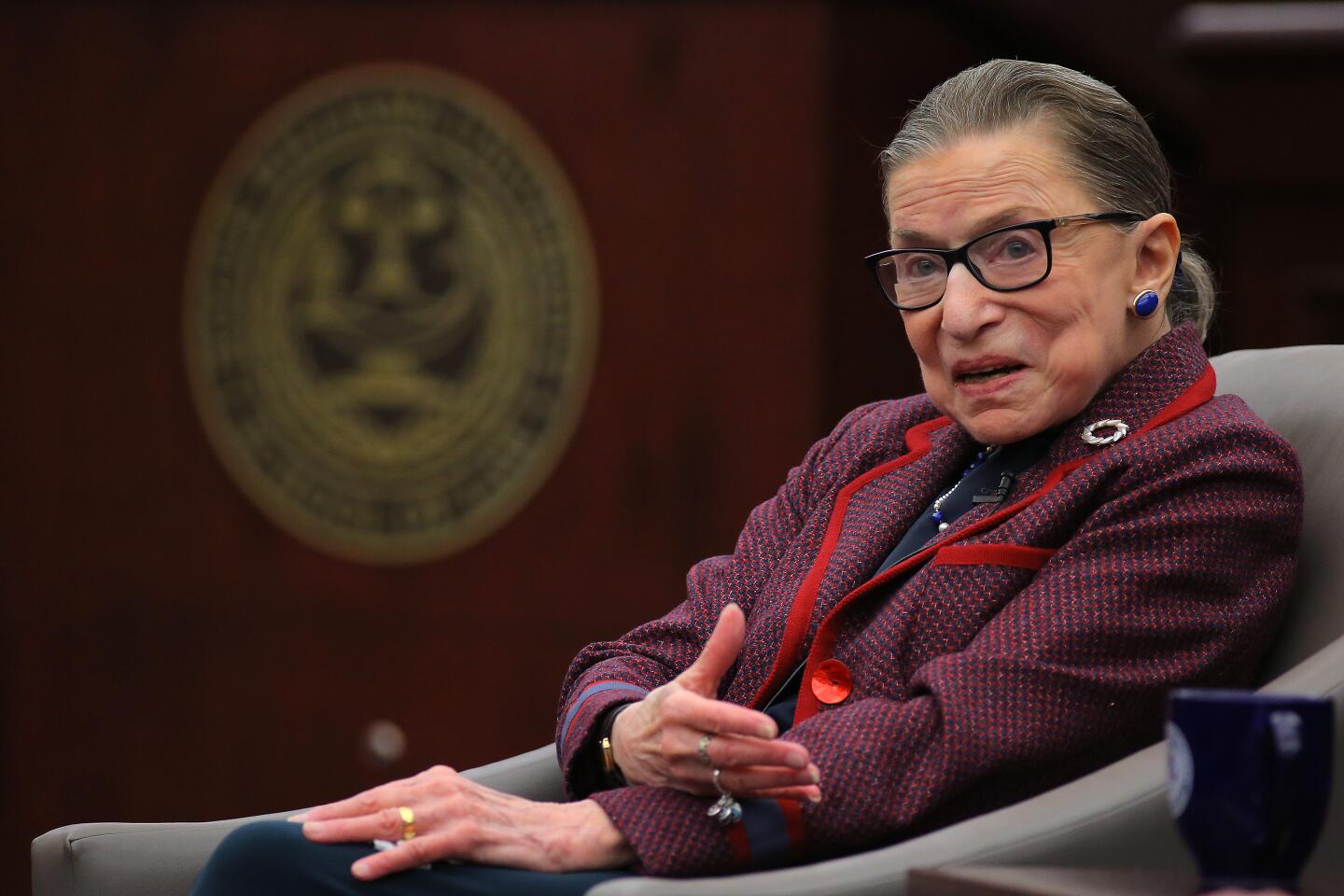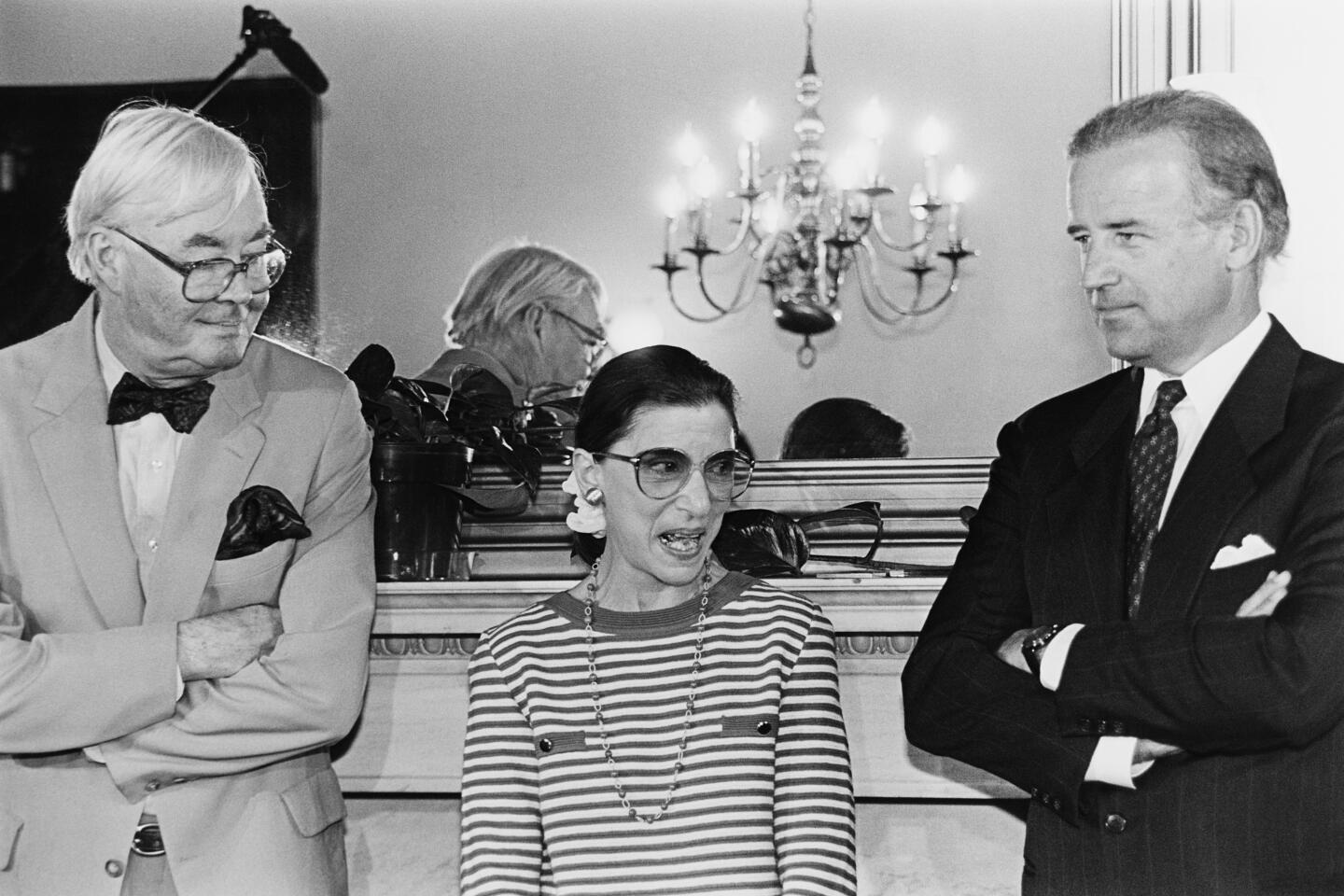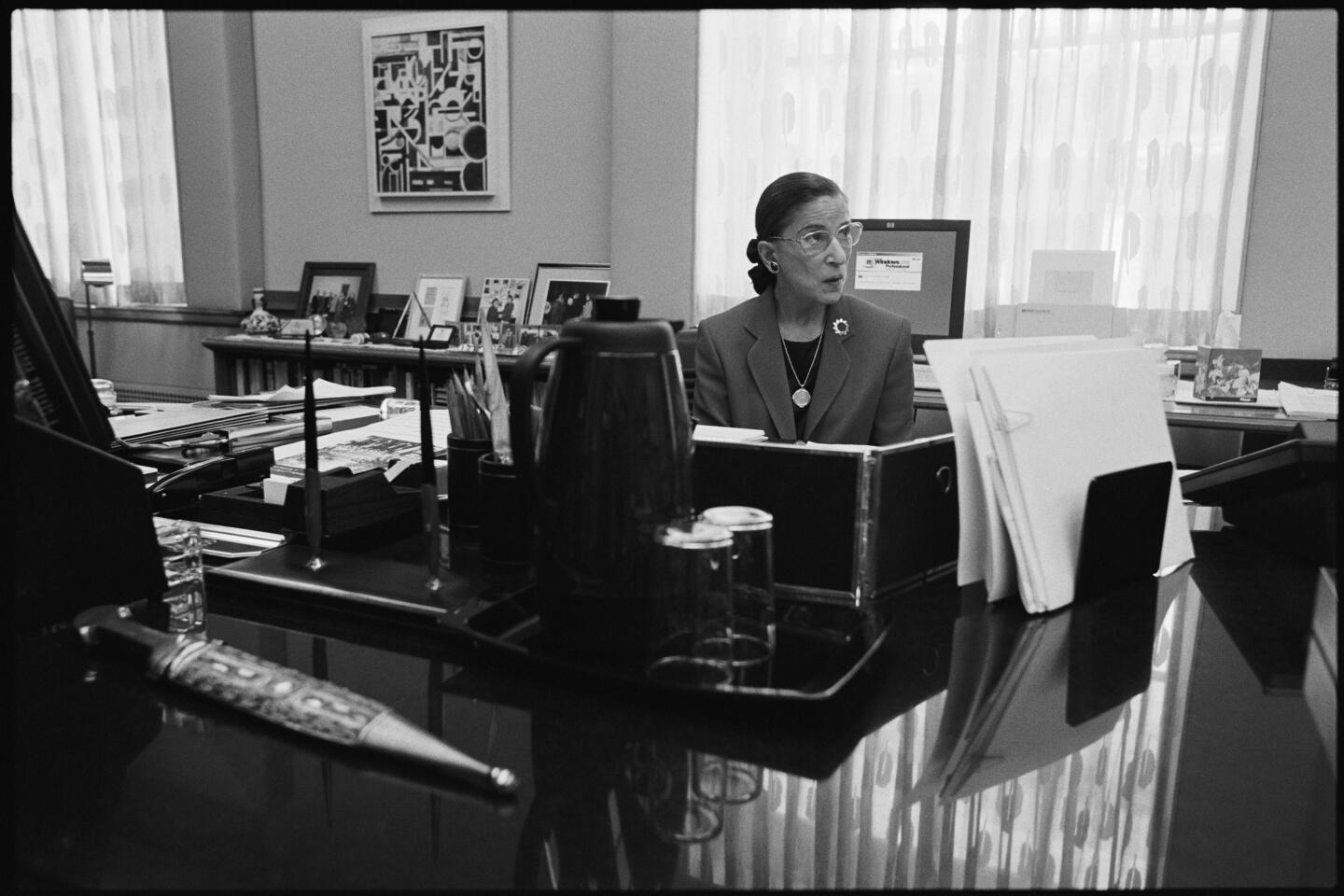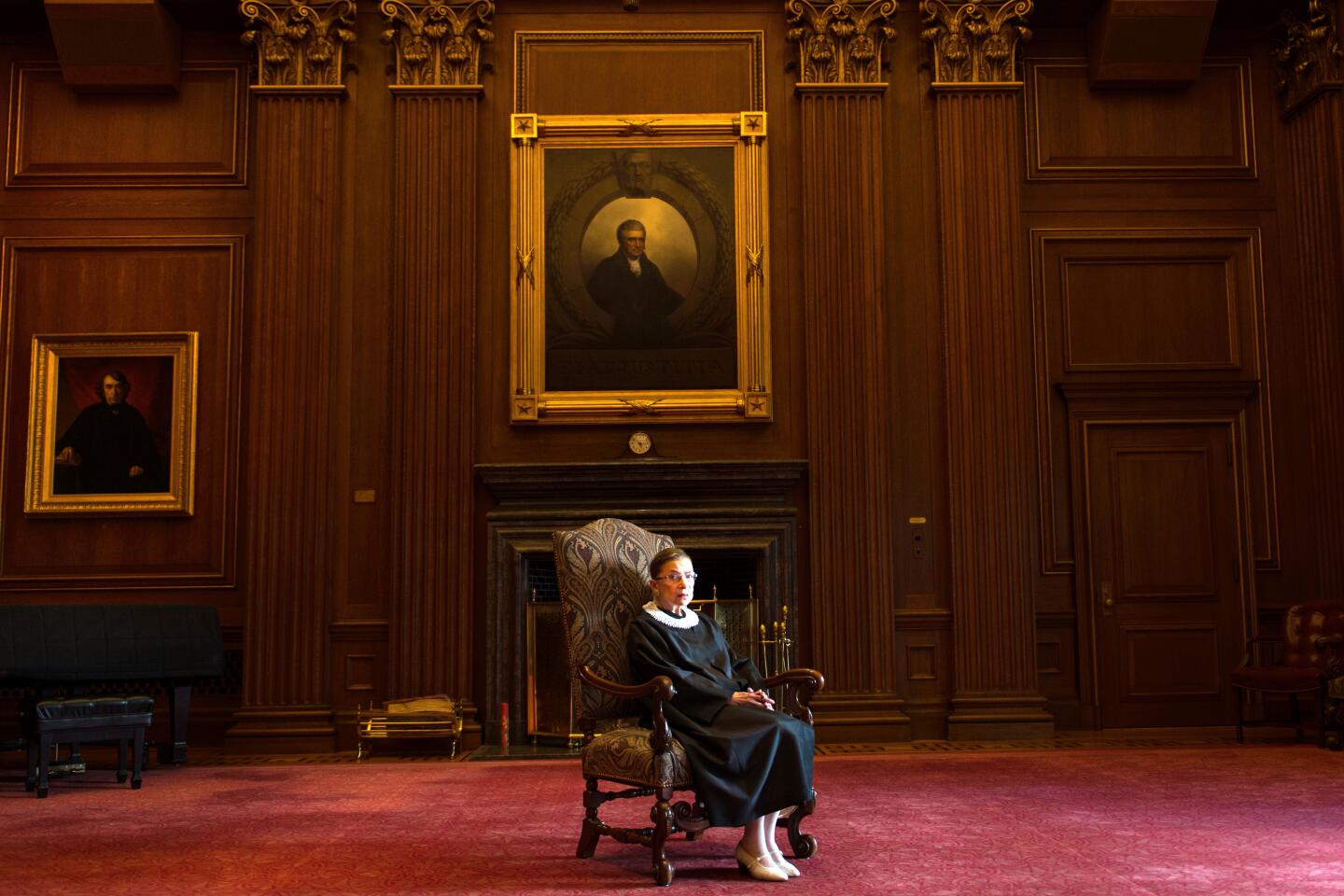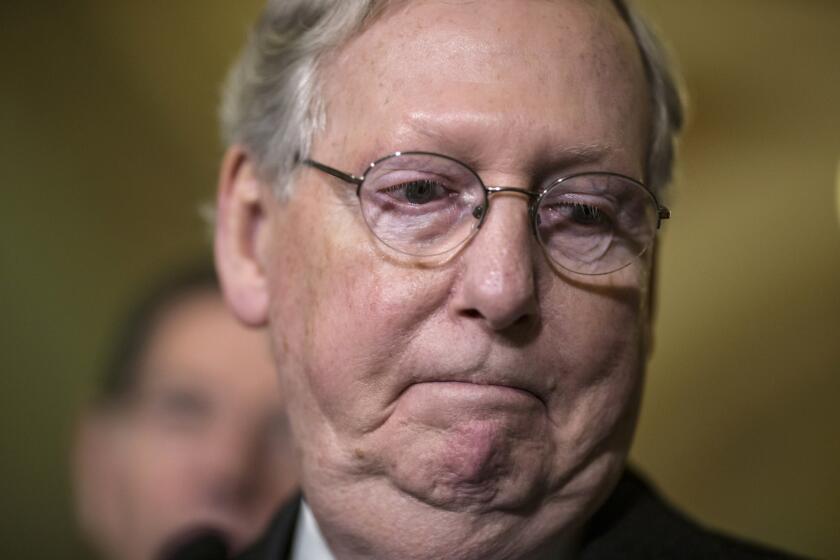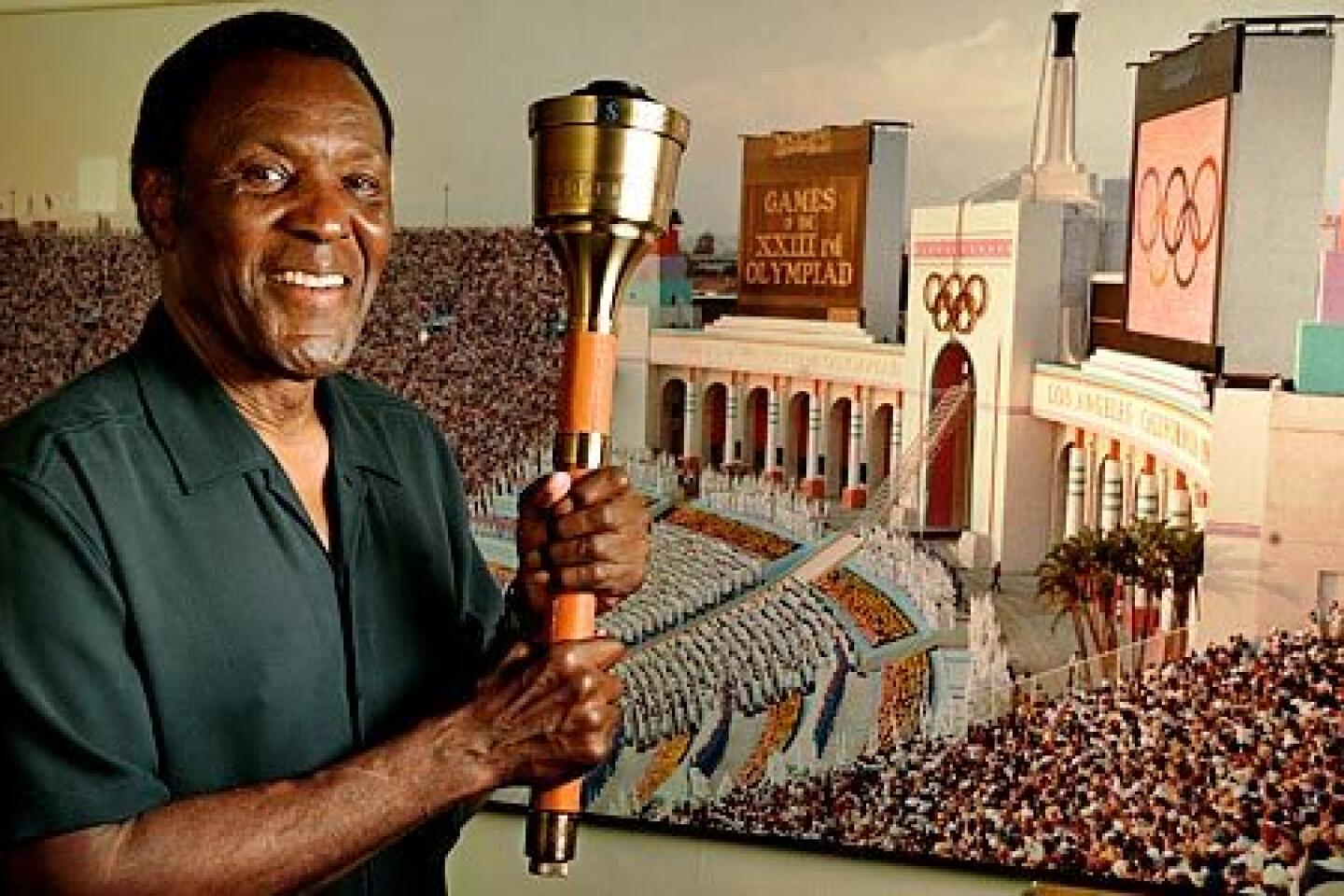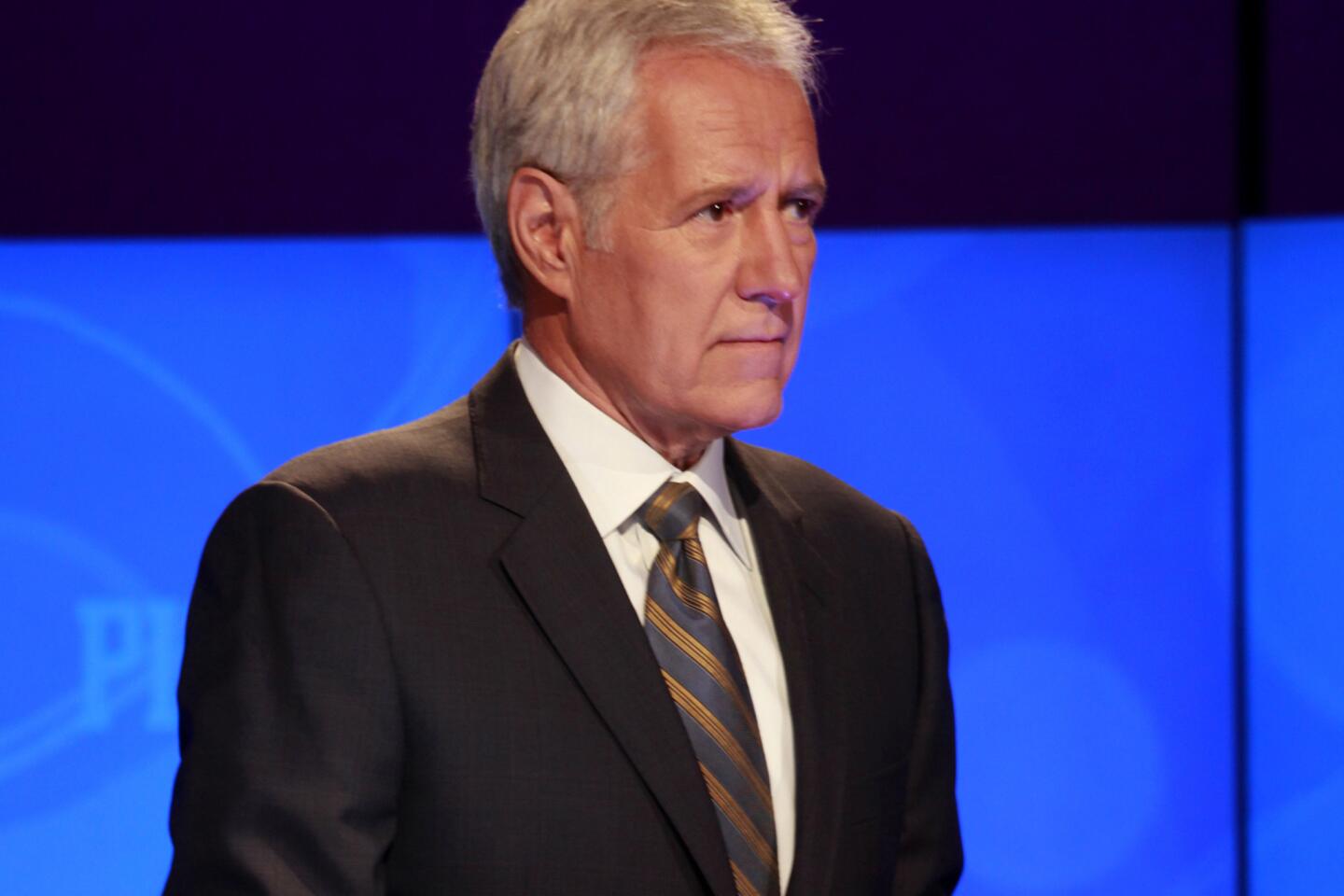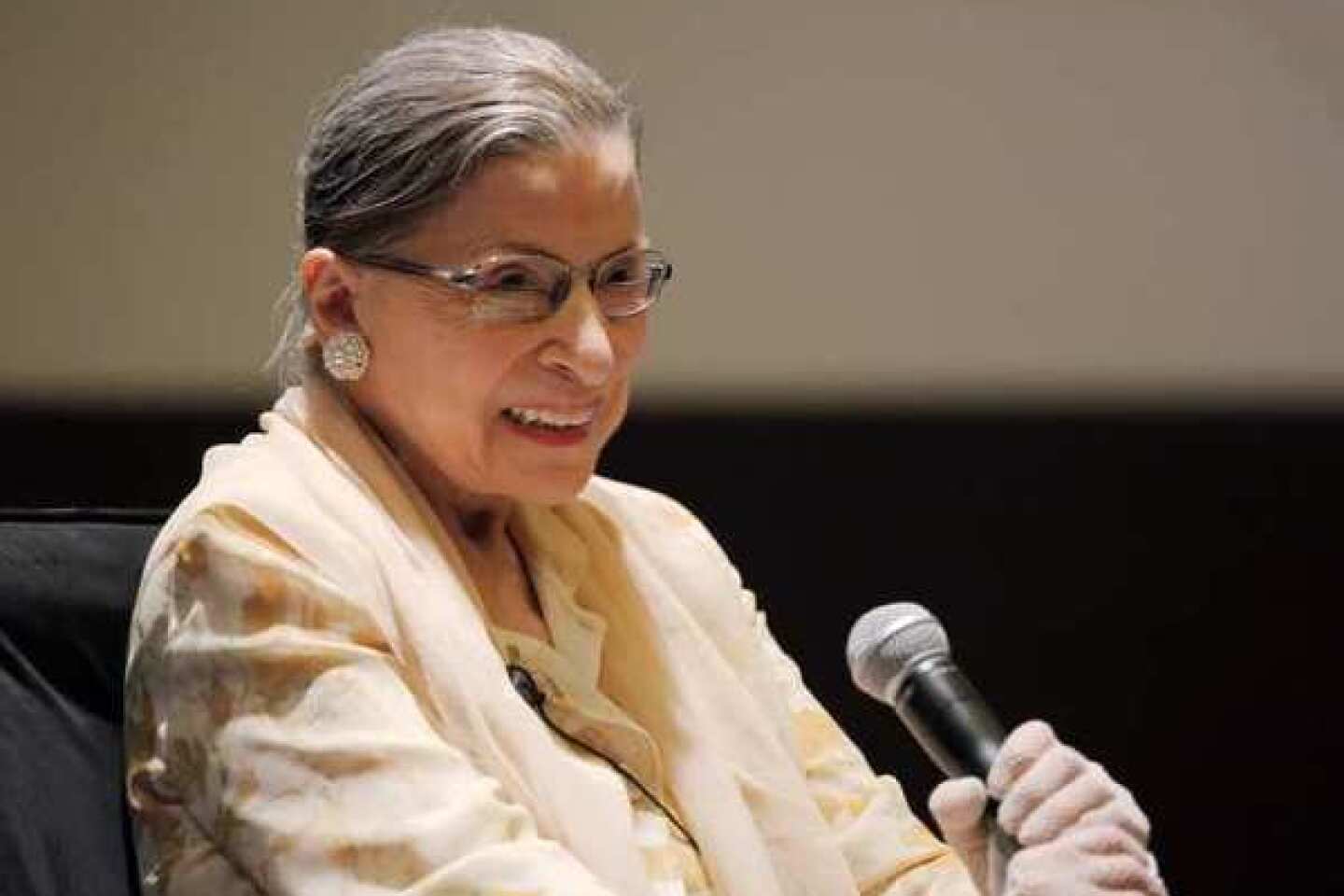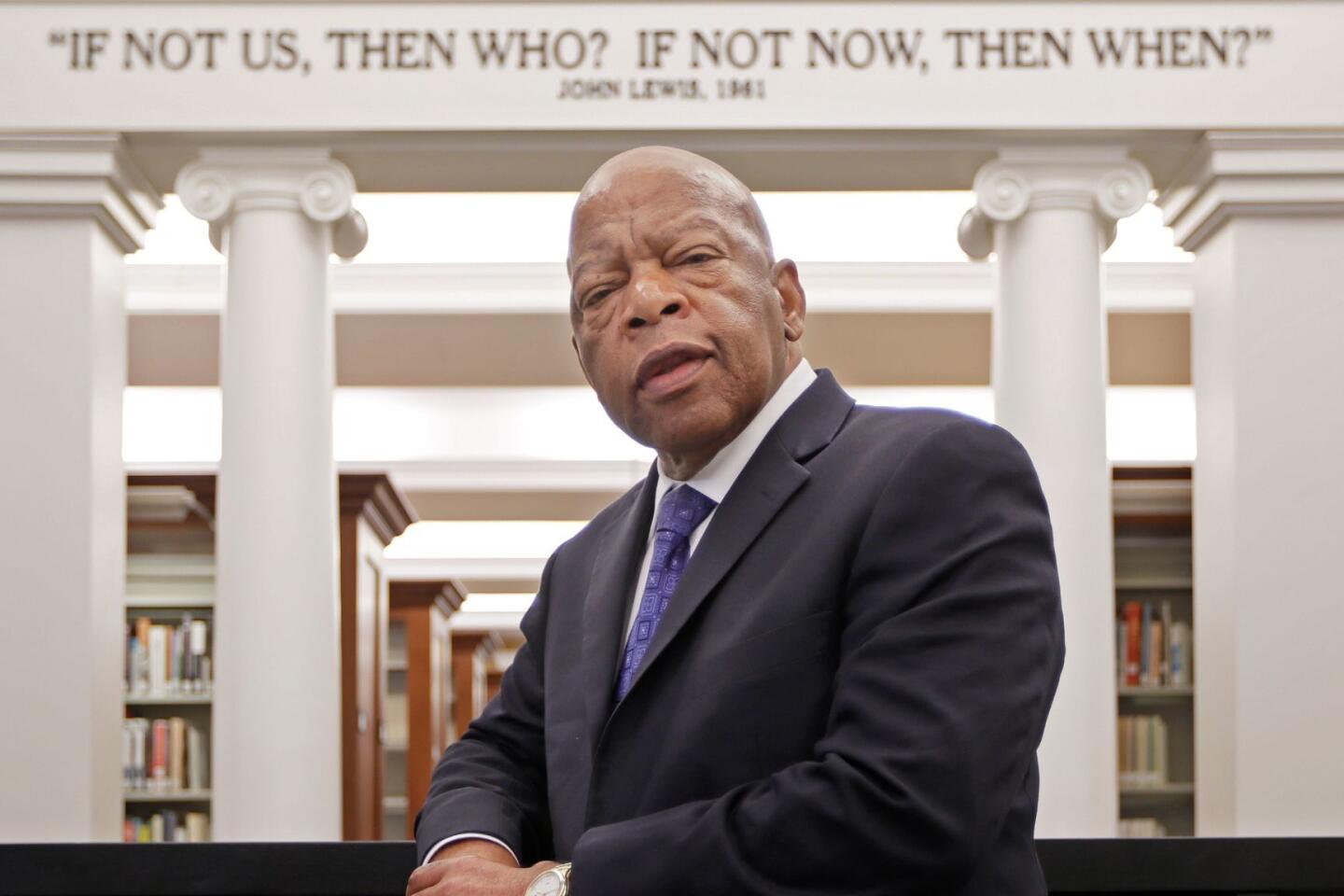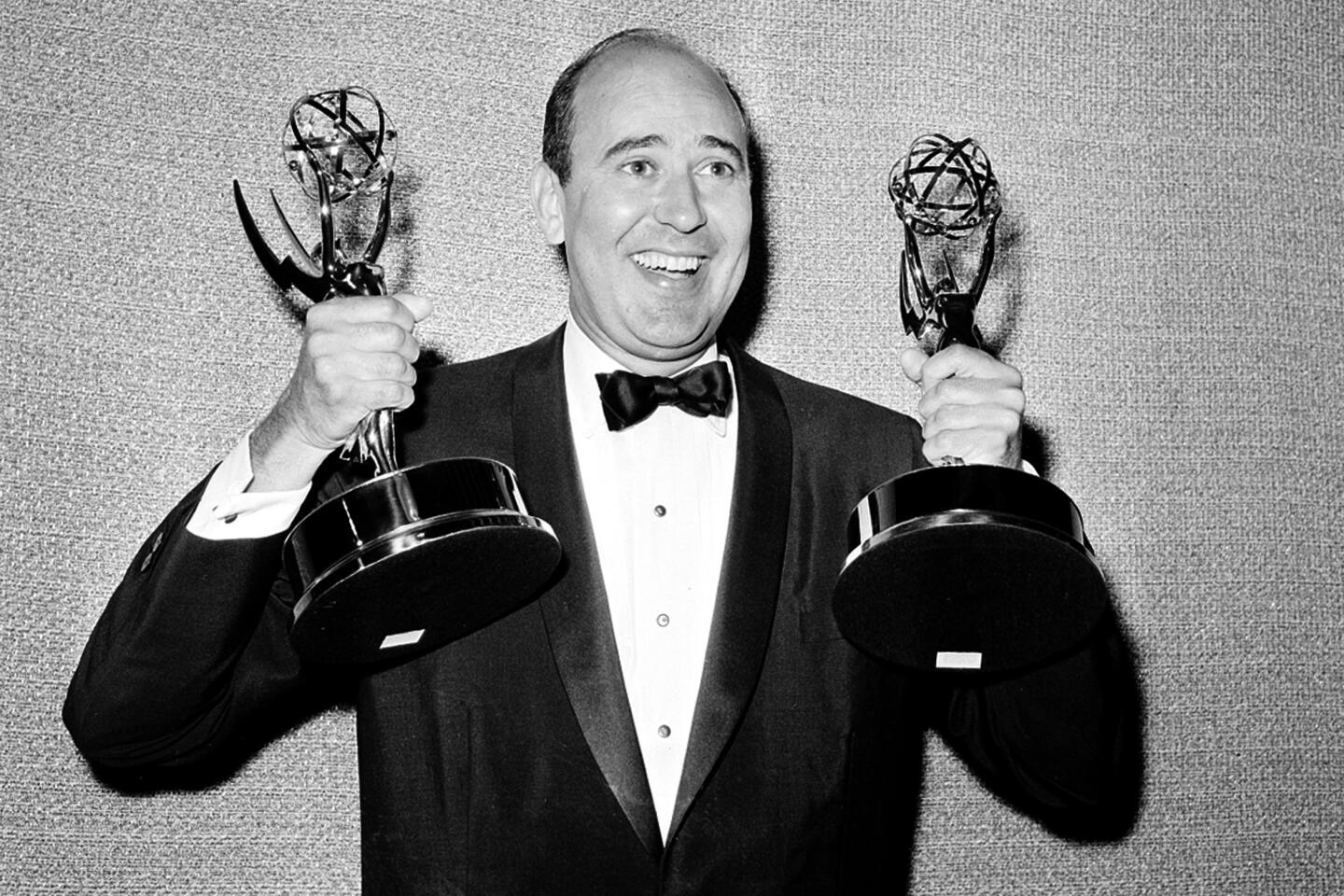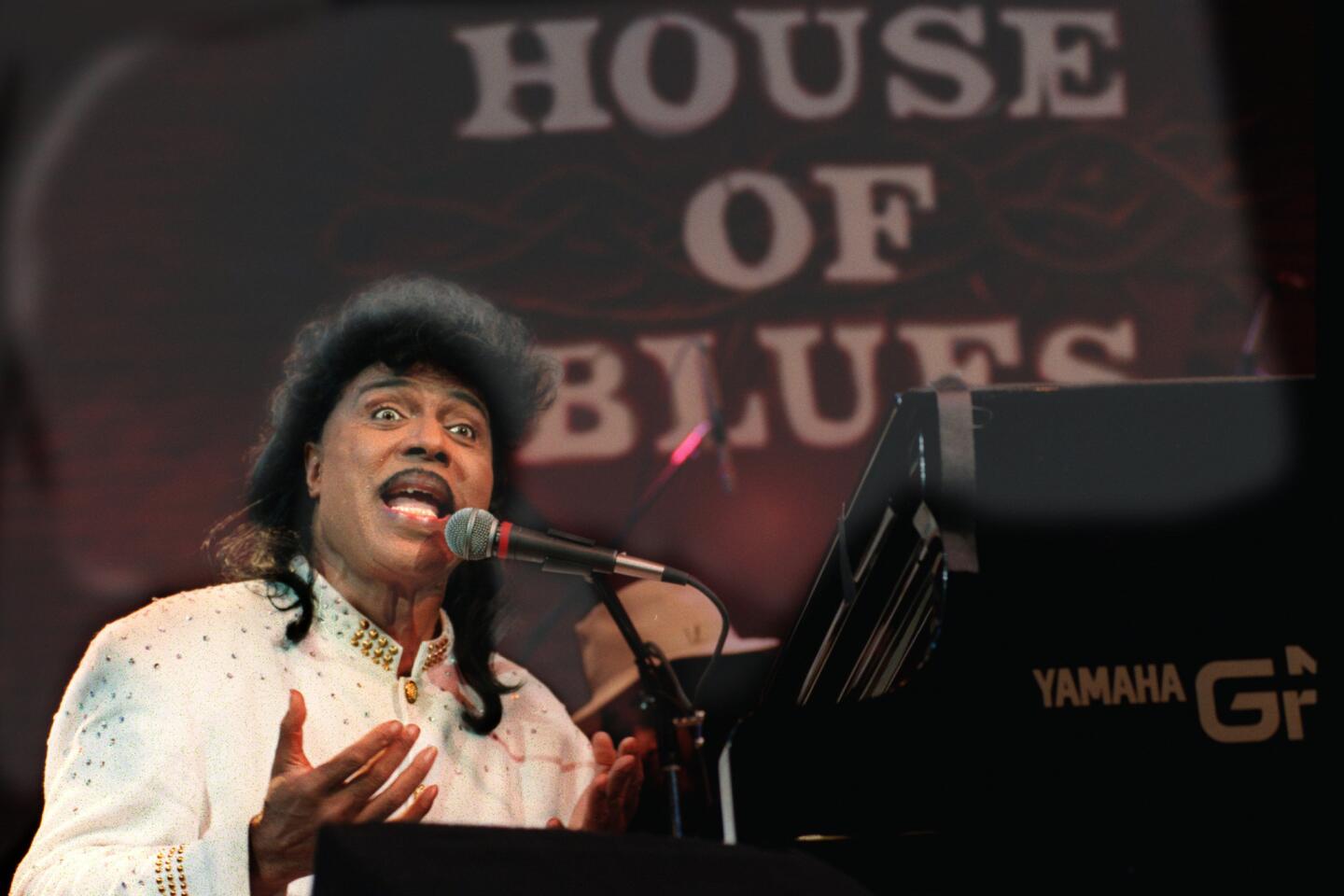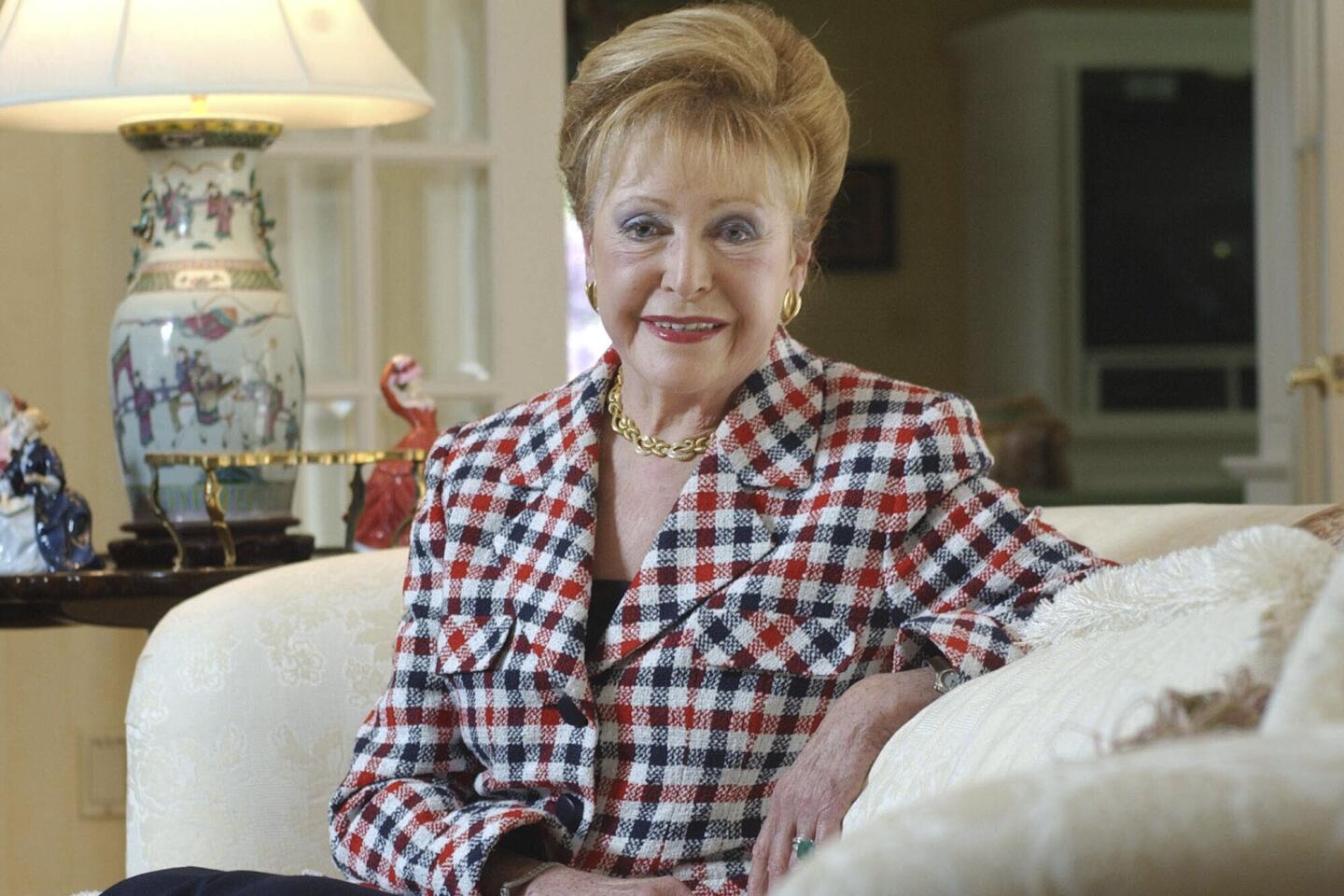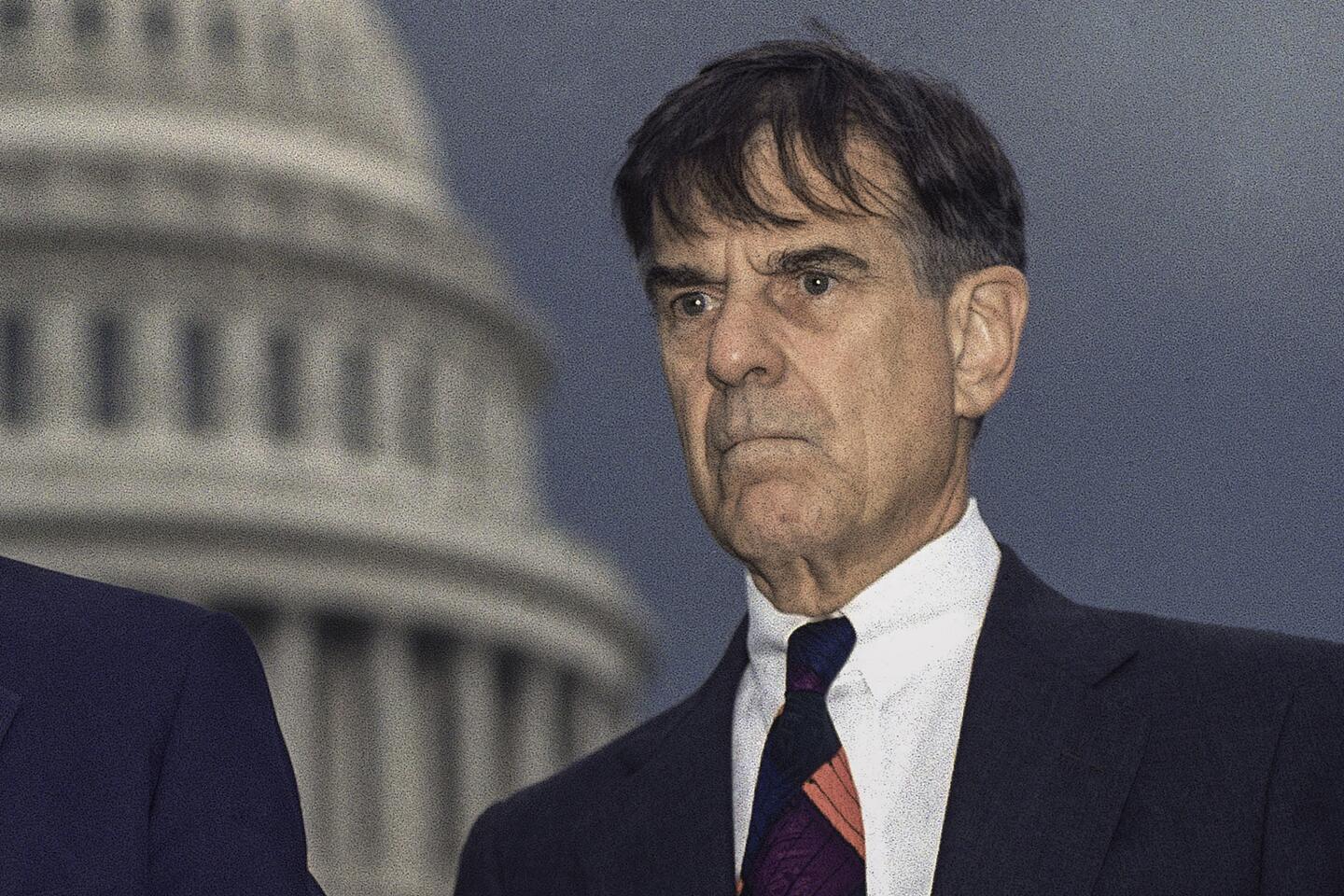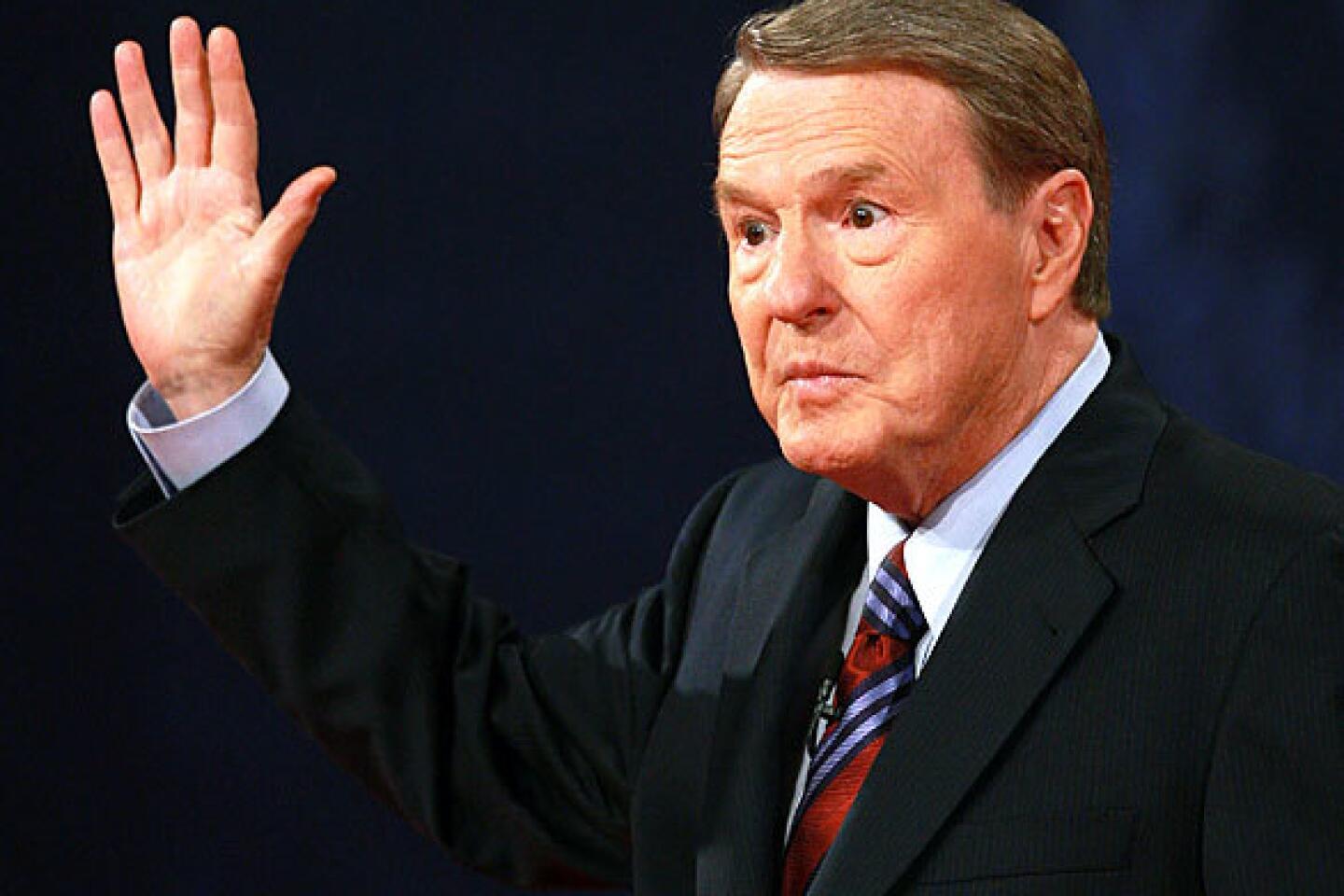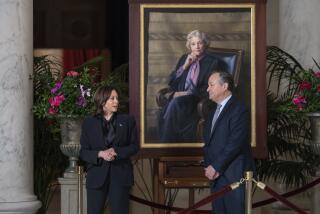Ruth Bader Ginsburg, liberal giant of the Supreme Court, dies
Justice Ruth Bader Ginsburg was the second woman to serve on the Supreme Court and the first to become a pop culture icon.
WASHINGTON — Justice Ruth Bader Ginsburg, who championed women’s rights — first as a trailblazing civil rights attorney who methodically chipped away at discriminatory practices, then as the second woman to serve on the Supreme Court, and finally as an unlikely pop culture icon — has died at her home in Washington.
Ginsburg, who had battled cancer for more than a decade, died Friday evening due to complications of the disease, the U.S. Supreme Court announced. She was 87.
A feminist hero lovingly dubbed Notorious RBG, Ginsburg emerged over the last decade as the leading voice of the court’s liberal wing, best known for her stinging dissents on a bench that has mostly skewed right since her 1993 appointment.
“Our nation has lost a jurist of historic stature. We at the Supreme Court have lost a cherished colleague,” Chief Justice John G. Roberts Jr. said. “Today we mourn, but with confidence that future generations will remember Ruth Bader Ginsburg as we knew her — a tireless and resolute champion of justice.”
Her death in the middle of the presidential campaign sets the stage for a momentous fight over whether President Trump and Senate Majority Leader Mitch McConnell (R-Ky.) can replace her with a conservative jurist before the November election.
McConnell has already said he intends to have a vote, although he did not say when it would be held. It remains unclear whether enough Republicans would go along with such a move, and Democrats are certain to oppose it. McConnell refused to consider President Obama’s Supreme Court nominee during the 2016 election year, saying the new president should decide.
President Trump is urging the Senate to consider his upcoming nomination for the Supreme Court seat vacant after Justice Ruth Bader Ginsburg’s death.
Ginsburg’s health had been precarious for more than a decade. She was successfully treated for cancer of the colon, pancreas and lung, but had a recurrence of pancreatic cancer in the spring.
Some liberal activists had urged her to retire in 2014, when Obama could have chosen her successor. But she said she was determined to serve as long as her health permitted.
President Trump had just finished speaking at a campaign rally in Minnesota when he was told of Ginsburg’s death.
“She just died? Wow. I didn’t know that,” he said. “She led an amazing life. What else can you say? She was an amazing woman.... I’m sad to hear that.”
He made no immediate comment about whether he would move to replace her.
Democratic presidential candidate Joe Biden called Ginsburg “not only a giant in the legal profession, but a beloved figure. ... And she practiced the highest American ideals as a justice: equality and justice under the law, and Ruth Bader Ginsburg stood for all of us.”
Biden said whoever is elected in November should choose her replacement.
“This was the position the Republican Senate took in 2016 when there were almost 10 months to go before the election,” he said. “That’s the position the United States Senate must take today. The election is only 46 days off.”
Sen. Dianne Feinstein (D- Calif.), the ranking Democrat on the Senate Judiciary Committee, said the nation had “lost a truly amazing woman tonight, a trailblazer for women, a once-in-generation legal mind and a passionate champion for the rights of all Americans.
“Under no circumstances should the Senate consider a replacement for Justice Ginsburg until after the presidential inauguration,” she said.
For her first two decades, Ginsburg was a respected but not highly influential member of the high court — a reliable liberal vote who was often overshadowed by Justice Sandra Day O’Connor, the first female justice and the court’s swing vote.
But after O’Connor and Justice John Paul Stevens retired, Ginsburg became a major force on the court, her soft voice and diminutive stature belying a biting tongue and inexhaustible energy that pushed her to work through numerous health scares, including a 2018 fall that left her with broken ribs.
Our Supreme Court reporter recalls the private side of Ruth Bader Ginsburg.
She wrote several major decisions, including a 1996 ruling in U.S. vs. Virginia that opened the doors of Virginia Military Institute to women and struck down discriminatory admissions policies of state-run schools. She supported abortion rights, gay rights, affirmative action and the strict separation of church and state.
But Ginsburg was best known for her impassioned dissents, which she often delivered in court while wearing a special dark, beaded “dissent collar” over her traditional black robe.
She called it “hubris” in 2013 when the court’s five conservatives struck down a key part of the Voting Rights Act as outdated. Tossing out the protection, she said, “is like throwing away your umbrella in a rainstorm because you are not getting wet.”
A year later, she slammed the same five for ruling that Hobby Lobby Corp. had a religious-freedom right not to pay for legally required contraceptives for their employees. Corporations do not have religious views, she said, and Congress “left healthcare decisions — including the choice among contraceptive methods — in the hands of women.”
During oral arguments over a 2013 gay marriage case, Ginsburg said the government’s Defense of Marriage Act effectively had set up an unfair, two-tier system.
“There are two kinds of marriage: full marriage and the skim-milk marriage,” she said.
Directors Julie Cohen and Betsy West spent years with the late Supreme Court Justice Ruth Bader Ginsburg to make their Oscar-nominated film ‘RBG.’
In that case, she was part of the majority that overturned the federal law.
Perhaps her most notable dissent came in 2007, when Ginsburg — then the only female justice — described herself as “all alone in [her] corner of the bench” following O’Connor’s retirement.
A five-member majority had overturned a sex discrimination verdict in favor of Lilly Ledbetter, an Alabama woman who was paid far less than the men who held the same job at Goodyear Tire plants. The majority ruled that Ledbetter had waited too long to file her complaint, though that was because she had been unaware of the disparity.
Ginsburg, in dissent, said the majority “does not comprehend, or is indifferent to, the insidious way in which women can be victims of pay discrimination.” Its interpretation of the law “ignored the realities” of the workplace and betrayed the “core purposes” of the Civil Rights Act, she said.
Ginsburg said Congress should act to correct the court’s mistake, and two years later the House and Senate passed the Lilly Ledbetter Fair Pay Act, providing more time to file claims. It was the first measure signed into law by President Obama.
Well into her 80s, Ginsburg was surprised and delighted to discover she had become a celebrity, particularly among a new generation of women. Her appearances at universities and law schools drew large, adoring crowds, and her face adorned with a crown was featured on T-shirts and coffee mugs. She was the subject of several films, including “RBG,” a documentary.
If Republicans insist on replacing Ginsburg before a new president is in place, Democrats should vow to expand the court should they win the Senate and White House.
“It seemed that her dissents had really connected with a lot of people, especially millennials,” Betsy West, a co-director of the film, said after its release. “It’s this incongruousness of an 85-year-old Jewish grandmother who is speaking truth to power.”
At times, her frankness backfired. In a 2016 interview, Ginsburg called Donald Trump, then the Republican presidential nominee, a “faker,” saying: “He has no consistency about him. He says whatever comes into his head at the moment. He really has an ego.”
Such criticism of a political candidate was highly unusual for a sitting Supreme Court justice, and Ginsburg apologized.
There was also friction between Ginsburg and some liberals in 2014, when pressure grew for her to retire while Democrats still held the Senate and the White House, which could guarantee that her seat would be filled by another liberal. Ginsburg brushed aside such concerns and let it be known she was not going anywhere, saying she still had a lot to contribute to the court.
In 2014, Republicans claimed the Senate majority, and two years after that the White House was won by Trump, who had promised to appoint only conservative, anti-abortion justices.
Ginsburg was the first Democratic nominee to the high court in a quarter of a century when she was chosen in 1993 by President Clinton.
The world changed, politics roared, America’s mood shifted this way and that, and Ginsburg worked, steadily as she had always done, dismantling injustice wherever she could.
Ironically, she was not immediately embraced by liberals and women’s rights activists. Some feared she was too moderate, and others were concerned by Ginsburg’s past criticism of the landmark abortion ruling Roe vs. Wade.
But Ginsburg’s objections were not about the outcome of the ruling. Rather, she believed the court’s opinion should have been based on more solid legal footing, namely a woman’s right to equal treatment under the 14th Amendment rather than a court-created “right to privacy.”
In her interview for the appointment, Ginsburg impressed Clinton, who hailed her as the Thurgood Marshall of the women’s rights movement.
Where Marshall, before he became the nation’s first African American justice, led the legal fight against racial discrimination in the 1940s and ’50s, Ginsburg led the legal fight against sex discrimination in the 1970s.
“She helped us read our Constitution to understand that it protects us all,” Yale Law professor Judith Resnik said. “She brought vision, skill, intellect and kindness to the law.”
Ginsburg grew up at a time when the law treated men and women differently. And though racial discrimination came to be widely seen as cruel and wrong, gender distinctions enjoyed a better reputation, at least among powerful men.
“Legislators and judges, in those years, were overwhelmingly white, well-heeled and male,” Ginsburg said years later, saying they saw gender discrimination as “operating benignly in women’s favor.”
Though she graduated first in her class at Columbia Law School, Ginsburg could not get an interview to be a clerk at the all-male Supreme Court and struggled to even find employment in New York City.
The Supreme Court, led by Chief Justice Earl Warren, had struck down racial segregation in 1954 and ruled the “equal protection” clause of the Constitution did not allow legal discrimination by race. But the court’s support for civil rights did not extend to women’s rights.
In 1961, the Warren court said a “woman is still regarded as the center of home and family life,” so women may be excused from serving on juries. The unanimous opinion in Hoyt vs. Florida rejected the claim of an abused woman who had killed her husband with a baseball bat and was convicted by an all-male jury. Gwendolyn Hoyt, the defendant, did not see Florida’s law as benign. She believed female jurors would have had a better understanding of her plight.
Ginsburg became a counsel for the American Civil Liberties Union, and by 1972 led its Women’s Rights Project. She set out to change the court’s view of gender bias and its impact on women and men.
She did not rely on grand pronouncements about inequality or take on hot controversies such as abortion. Instead, she planned a careful, step-by-step approach to undercut sexist laws. She pressed a series of seemingly minor cases — often on behalf of men — that demonstrated gender discrimination hurt both men and women.
For example, the Social Security Administration at the time paid a survivor’s benefit to a widow after her husband died, but not to a widower whose wife had died. This might have been seen, at first glance, as a gender preference in favor of women. Ginsburg did not think so. When Stephen Wiesenfeld’s wife died during childbirth in 1972, he had to raise his son alone, and sued to obtain a survivor’s benefit from Social Security.
Ginsburg took the Wiesenfeld case to the Supreme Court and won a unanimous decision in 1975 holding this discrimination against widowers was unconstitutional. It was unfair to the surviving husband, but it was also unfair to the wife who had paid Social Security taxes at the same rate as men, but could not pass on the benefit to her surviving family. And it was unfair to their baby, who needed all the support his widowed father could obtain.
Thanks in part to Ginsburg’s efforts, the liberal Warren court that had accepted gender discrimination in the 1960s was succeeded by the supposedly conservative Burger court of the 1970s, which derided as “archaic” the notion that gender discrimination was benign.
Ginsburg won five of the six cases she took to the high court in the 1970s, and by the time she left the ACLU to become a judge, she had largely succeeded in establishing the principle that the Constitution prohibited nearly all gender discrimination in law.
In 1980, President Carter named Ginsburg to the U.S. Court of Appeals for the District of Columbia, often described as the nation’s second-highest court. A year later, President Reagan named O’Connor, a state appeals judge from Arizona, to be the first woman on the Supreme Court. And 12 years later, Ginsburg joined O’Connor as the second female justice.
Ginsburg was born Ruth Joan Bader on March 15, 1933, in Brooklyn, N.Y., the second daughter of Nathan and Celia Bader. But she grew up as an only child when her older sister died of meningitis. Her mother had a great love of reading and language, and Ruth excelled as a student. But on the day before her high school graduation in 1950, her mother died after a long illness with cervical cancer.
On the day Ginsburg was nominated to the Supreme Court, she brought tears to many eyes at the White House when she paid tribute to her mother. She recalled her as “the bravest and strongest person I have known, who was taken from me too soon. I pray that I may be all that she would have been had she lived in an age when women could aspire and achieve and daughters are cherished as much as sons.”
A few months after her mother’s death, Ginsburg left Brooklyn for Cornell University, where she had won a scholarship and met her future husband, Martin Ginsburg. She enrolled as one of nine women in a Harvard Law class of 500 and was elected to the Harvard Law Review. But she transferred to Columbia after her husband, a Harvard Law graduate and an expert in tax law, joined a New York firm.
She was tied for the honor of top student when she graduated in 1959, but “not a single law firm in the city of New York bid for my employment,” she recalled. At the Supreme Court, Justice Felix Frankfurter refused to interview her, saying he was not ready to hire a woman as a law clerk.
Justice William O. Douglas had hired Lucile Lomen as the first female clerk in 1944, but it would be 22 years before a second woman was hired.
Ginsburg clerked for a federal district judge and then began a long teaching career at Rutgers, then Columbia. She had two children: Jane, who also became a Columbia law professor, and James, who became a classical music producer.
Friends often described the Ginsburgs as an ideal, odd couple. He was outgoing, funny and loved to cook. She was shy, scholarly and devoted to the law.
“If you didn’t know them but were told one was a tax professor and one was a figure at the Supreme Court, you’d probably guess wrong twice,” said Alan Morrison, a veteran Washington lawyer.
In public presentations, they joked about their role reversal. “My wife does not give me any advice about cooking, and I do not give her any advice about the law,” her husband said.
Ginsburg recalled that when they met as undergraduates at Cornell, “he was the only guy I ever dated who cared whether I had a brain.”
When he had an early bout with cancer, she helped him get through law school by doing his work as well as hers. And throughout her career, he was her most effective booster.
In the spring of 1993, when Clinton was going back and forth on whom to appoint to the Supreme Court, Martin Ginsburg led a letter-writing campaign to convince the new president that the best option was not a politician like Mario Cuomo or George J. Mitchell, but an experienced federal appeals court judge who had led the fight for gender equality. It worked: Judge Ginsburg got an interview with the president, and Clinton was convinced she was the right choice.
Her husband died in late June 2010, as the court was in its last week of the term. Ginsburg was famous for never missing a day when the court was in session, and the day after her husband’s death, she was on the bench to read an opinion. Although she was dry-eyed, Justice Antonin Scalia was in tears.
The friendship between Ginsburg and the outspoken and combative Scalia struck many as surprising, especially for Washington. She was a liberal Democrat. He was a conservative Republican. But they were good friends long before they joined the high court.
They both grew up in New York City in the 1940s and ’50s, and became judges on the U.S. Court of Appeals in Washington in the early 1980s. They shared a love of opera and a love of the law. The Ginsburgs also liked to entertain “Nino” and Maureen Scalia at their apartment in the Watergate complex.
Ginsburg proudly displayed two photos in her court chambers. In one, she and Scalia are in costume for a guest appearance in an opera. In the other, they are riding atop an elephant in India.
“Her feminist friends” were upset, Scalia told a college crowd, because “she rode behind me.”
Undaunted, Ginsburg reported the driver had explained it was “a matter of distribution of weight.” The audience, Scalia included, roared with laughter.
Their friendship aside, Ginsburg and Scalia took opposite sides in all the major disputes before the court. Scalia, however, did not attack her in print. His opinions often included sharp jabs, even mockery, when he disagreed with other justices, including O’Connor, Anthony M. Kennedy, Stephen G. Breyer and even conservative Chief Justice Chief William H. Rehnquist. But there was never an unkind comment from him directed toward Ginsburg.
More to Read
Start your day right
Sign up for Essential California for the L.A. Times biggest news, features and recommendations in your inbox six days a week.
You may occasionally receive promotional content from the Los Angeles Times.
